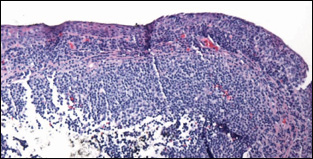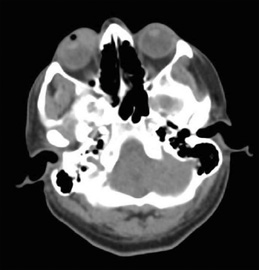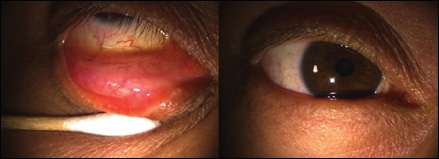Man presents with enlarging mass inside right eyelid
The right eye had two hyperemic, salmon-colored lesions on the inferior and superonasal bulbar conjunctiva.
Click Here to Manage Email Alerts
A 39-year-old man presented to the New England Eye Center with a slowly enlarging mass in the right eye that had become more noticeable over the past 2 weeks. His complete ocular and systemic review of systems was negative, including recent trauma, headache, sinus congestion, recent illness, fever, night sweats or unintended weight loss. His ocular history was notable for allergic conjunctivitis for which he used over-the-counter antihistamine drops as needed. He had no other significant medical or surgical history. His family history was noncontributory. He did not regularly use any systemic medications. He denied tobacco and recreational drug use and reported occasional alcohol use.
Examination
Upon examination, best corrected visual acuity was 20/25+ in the right eye and 20/20-1 in the left eye. There was no afferent pupillary defect in either eye. IOPs were within normal limits. Extraocular movements were grossly full, but the patient complained of pain with downgaze.

Source: Deborah Witkin, MD, and Michael B. Raizman, MD
Examination of the right eye revealed lower lid fullness and reverse ptosis. There were two hyperemic, salmon-colored lesions in the inferior bulbar conjunctiva and superonasal bulbar conjunctiva. The inferior lesion extended above the right inferior eyelid margin and over the medial caruncle (Figure 1). No abnormal conjunctival vessels were identified. The patient was noted to have endothelial pigment on both corneas and rare pigmented cells in both anterior chambers. No iris transillumination defects were seen in either eye. He had trace pigment on the anterior capsule of both eyes. Dilated fundus exam of both eyes was within normal limits.
What is your diagnosis?
See answer on next page.
Lesions
Based on the location and appearance of the lesions, the differential diagnosis included lymphoma, reactive lymphoid hyperplasia, orbital metastasis, conjunctival inclusion cyst, mucocele and lymphangioma. Less likely diagnoses included oncocytoma, squamous neoplasia and idiopathic orbital inflammatory syndrome. Incisional biopsy of the inferior bulbar lesion was performed 2 weeks after the initial consultation. Both fresh and fixed tissue samples were sent to pathology.




Diagnosis
Pathology slides showed an atypical, vaguely nodular lymphocytic infiltrate. The lymphocytes consisted of small mature forms without any large forms represented (Figure 2). Immunohistochemistry stains revealed that the cells consisted of CD-20 positive B-cells co-expressing bcl2 (Figure 3). The cells were found to be negative for bcl-6, CD10, Cyclin D1 and CD5. Ki67 stain showed rare neoplastic cell nuclei consistent with low-grade features. The final diagnosis was low-grade B-cell lymphoproliferative disorder of mucosa-associated type (MALT lymphoma).
Management
A PET scan was performed and showed two right parotid prominent lymph nodes with a mild uptake of standardized uptake value (SUV) of 1.8 maximum and no distant disease (Figure 4). The primary lesion in the right eye was SUV maximum 7 and measured 2 cm. The patient’s lymphoma was graded as stage 1AE. He was seen by radiation oncology and ultimately received a total of 24 Gray of radiation given over 16 fractions. At 5 months after initial evaluation, his visual acuity was 20/20-2 in both eyes. He had mild, improving right lower lid fullness, and the salmon-colored lesion in the inferior fornix was completely hidden by the eyelid. He had a few spots of pigment nasally on the conjunctiva with scarring and moderate elevation (Figure 5). He is being monitored twice yearly for signs of recurrence or radiation damage to the ocular tissues.
Discussion
MALT lymphoma, also known as extranodal marginal zone B-cell lymphoma, accounts for 43% to 86% of all ocular adnexal lymphomas. Of these adnexal MALT lymphomas, roughly one-third of tumors are conjunctival. In general, conjunctival lesions portend a better prognosis than orbital or eyelid tumors. Systemic dissemination has been found to occur in 17% to 30% of cases. MALT lymphomas are typically slow-growing, indolent tumors.
According to a recent study, orbital MRI has a very low yield in detecting the presence of conjunctival MALT lymphoma. In this study, 14 of 17 patients (82%) with obvious lymphoma on clinical exam had no identifiable lesions on MRI. Four of 18 patients (22%) showed hypermetabolic activity on whole-body PET scan. None of the patients in the study had positive findings on bone marrow biopsy or GI endoscopy. Despite the small sample size, this study suggests that MRI, bone marrow biopsy and GI endoscopy may be unnecessary for patients with suspected conjunctival lymphoma.
Treatment generally consists of either radiation therapy for localized disease (stage IE or IIE) or chemotherapy for widespread disease (stage IIIE or IVE). There are chemotherapeutic regimens that have been shown to be effective for MALT lymphoma, many of which include rituximab. Complete surgical excision is rarely performed for this lesion given the marked success of radiation therapy and the potential morbidity of performing a large local excision. Radiation therapy has been shown to affect the lens, retina and optic nerve. In one study of 77 patients treated with radiation for MALT lymphoma, 17 (22%) developed worsening cataracts, four (5%) had loss of two or more lines of vision, and one (1%) had radiation retinopathy.
Overall, conjunctival MALT lymphoma is a relatively indolent tumor with effective treatment options. Our patient responded well to radiation treatment without evidence of local effects of radiation. He will continue to be monitored for recurrence or radiation effects.
- References:
- Kim SY, et al. Oncotarget. 2017;doi:10.18632/oncotarget.19788.
- Kirkegaard MM, et al. JAMA Ophthalmol. 2016;doi:10.1001/jamaophthalmol.2015.6122.
- Nasser QJ, et al. Leuk Lymphoma. 2014;doi:10.3109/10428194.2013.826353.
- Platt S, et al. Ocul Oncol Pathol. 2017;doi:10.1159/000453615.
- Shields CL, et al. Asia Pac J Ophthalmol (Phila). 2017;doi:10.22608/APO.201710.
- For more information:
- Deborah Witkin, MD, and Michael B. Raizman, MD, can be reached at New England Eye Center, Tufts University School of Medicine. 800 Washington Street, Box 450, Boston, MA 02111; website: www.neec.com.
- Edited by Aubrey R. Tirpack, MD, and Astrid C. Werner, MD. They can be reached at the New England Eye Center, Tufts University School of Medicine, 800 Washington St., Box 450, Boston, MA 02111; website: www.neec.com.
